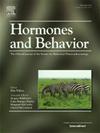Sex- and site-specific effects of GPER-1 activation on saccharin vs cocaine preference in male and female rats
IF 2.5
3区 医学
Q2 BEHAVIORAL SCIENCES
引用次数: 0
Abstract
Estradiol (E2) receptor signaling has a sex-specific impact on the brain's reward pathway, enhancing cocaine reinforcement in females but not in males. Selective activation of G-Protein Coupled Estradiol Receptor 1 (GPER-1) in the dorsolateral striatum (DLS) attenuates the reinforcing effects of 0.1 % saccharin (SACC) and cocaine in males but not females. This study investigated GPER-1 activation in the DLS and systemically using the GPER-1 agonist G1 to assess its effect on SACC and cocaine preference in male and female rats. Five experiments were conducted using gonad-intact and gonadectomized animals to determine dose-response effects and the influence of circulating hormones. Intra-DLS GPER-1 activation with 20 % G1 selectively reduced SACC preference in intact males but not females, while higher and lower concentrations had no effect. Systemic G1 administration attenuated cocaine-induced conditioned place preference (CPP) in both sexes in a dose-dependent way. Interestingly, systemic administration of G1 did not alter SACC preference in either sex, regardless of the presence or absence of gonadal hormones. These findings suggest that GPER-1 activation influences reward processing in a site-, reward-, and sex-dependent manner.
GPER-1激活对雌雄大鼠对糖精和可卡因偏好的性别和位点特异性影响
雌二醇(E2)受体信号对大脑的奖赏通路有性别特异性影响,在女性中增强可卡因强化,而在男性中没有。g蛋白偶联雌二醇受体1 (GPER-1)在背侧纹状体(DLS)的选择性激活减弱了0.1%糖精(SACC)和可卡因对雄性的强化作用,而雌性没有。本研究研究了GPER-1在DLS中的激活,并系统地使用GPER-1激动剂G1来评估其对雌雄大鼠SACC和可卡因偏好的影响。我们用性腺完整和去性腺的动物进行了五项实验,以确定循环激素的剂量反应效应和影响。dls内GPER-1的20% G1激活选择性地降低了完整雄性的SACC偏好,但对雌性没有影响,而更高和更低浓度的GPER-1没有影响。系统性给药G1以剂量依赖的方式减弱两性可卡因诱导的条件位置偏好(CPP)。有趣的是,无论是否存在性腺激素,全身给药G1都不会改变两性对SACC的偏好。这些发现表明GPER-1的激活以位点依赖、奖励依赖和性别依赖的方式影响奖励处理。
本文章由计算机程序翻译,如有差异,请以英文原文为准。
求助全文
约1分钟内获得全文
求助全文
来源期刊

Hormones and Behavior
医学-行为科学
CiteScore
6.70
自引率
8.60%
发文量
139
审稿时长
91 days
期刊介绍:
Hormones and Behavior publishes original research articles, reviews and special issues concerning hormone-brain-behavior relationships, broadly defined. The journal''s scope ranges from laboratory and field studies concerning neuroendocrine as well as endocrine mechanisms controlling the development or adult expression of behavior to studies concerning the environmental control and evolutionary significance of hormone-behavior relationships. The journal welcomes studies conducted on species ranging from invertebrates to mammals, including humans.
 求助内容:
求助内容: 应助结果提醒方式:
应助结果提醒方式:


